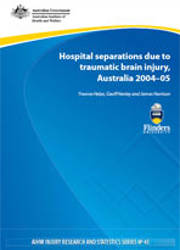Summary
Traumatic Brain Injury (TBI) is characterised by a blow or other force to the head which results in damage to the brain or an alteration in brain function. This report covers hospitalisations in Australia in 2004–05 where traumatic brain injury (TBI) was the principal diagnosis (62.5% of TBI-related cases), injury cases with TBI as an additional diagnosis (26.1% of cases), and other TBI cases (11.4%).
There were an estimated 22,710 hospitalisations involving traumatic brain injury in Australia in 2004–05. These hospitalisations resulted in over 26,000 episodes of inpatient care totalling nearly 206,000 days, and estimated direct costs of hospital care of $184 million. Trends Hospitalisation rates for TBI as a principal diagnosis remained stable from 1999–00 to 2004–05. A 7% increase was seen over the same period for injury cases with TBI as an additional diagnosis. For ‘other TBI’ cases there was a 33% increase in rates between 1999–00 and 2004–05, but this was off a low base, i.e. these rates were low at less than one-sixth the rates of TBI as a principal diagnosis.
Age and sex distribution
In 2004–05, for cases with TBI as a principal or additional diagnosis, rates of hospitalisation for males per 100,000 population were two and a half times those for females. For ‘other TBI’ cases, the rate for males was about double the female rate. The higher rates for males applied across all age groups. Rates of hospitalisation for TBI were highest for youth and young adults, and for seniors. For ‘other TBI’ cases, the highest rates occurred in people aged 75 years and over.
Causes of brain injury
The most common causes of brain injury in cases with TBI as principal diagnosis were falls (42%), transportation (29%) and assault (14%). Where TBI was an additional diagnosis, the most common causes were the same, but with transportation (42%) more common than falls (30%) and assault (16%). More females than males sustained TBI caused by falls; and much higher numbers of males than females sustained TBI caused by assault. Transportation accounted for equal proportions of TBI among males and females. Activity at the time of injury was recorded for about 47% of TBI cases. Among the cases where activity was recorded, sport was most commonly specified, particularly football. Hospital separations due to traumatic brain injury, Australia 2004–05.
Severity and survival
Concussion, and brief loss of consciousness (less than 30 minutes), occurred for many TBI patients: 60% of principal diagnosis cases; 59% of additional diagnosis cases, and 34% of ‘other TBI’ cases. Only 1.2% of patients in these groups experienced a loss of consciousness of prolonged duration (more than 24 hours). Overall, 4.3% of TBI cases resulted in death. Almost 12% of cases admitted with an intracranial injury (e.g. haemorrhage, haematoma) died in hospital compared with less than 1% of TBI cases without intracranial injury.
Preliminary material: Acknowledgements; Abbreviations
1. Introduction
- Background
- Purpose
- Literature review
- Case selection
- Severity measures
2. TBI as Principal Diagnosis
- Overview
- Principal Diagnosis
- Age and sex distribution
- Trends over time
- External Cause of injury
- Activity at time of injury
- Place of occurrence of injury
- Severity of Principal Diagnosis cases
- Fall related injury
- Age group
- Transport related injury
- Assault related injury
3. Injury cases with TBI as an Additional Diagnosis
- Overview
- Principal Diagnosis
- Intracranial injury
- Age and sex distribution
- Trends over time
- External Causes of injury
- Activity at time of injury
- Place of occurrence of injury
- Severity of injury cases with TBI as an Additional Diagnosis
- Mean ICISS score
4. Other TBI cases
- Overview
- Principal Diagnosis
- Intracranial injury
- Age and sex distribution
- Trends over time
- External Causes of injury
- Activity at time of injury
- Place of occurrence of injury
- Severity
5. Analysis of multiple head injury codes
- Introduction
- Overview
- Case type
- External Cause
- Age groups
- Remoteness
- Mode of separation
- Length of stay
- Place of occurrence
6. Burden of TBI on care in hospitals
- Separations with TBI code (S06) in any diagnosis field
- Separations with sequelae of intracranial injury code (T90.5) in any diagnosis field
- Separations involving follow-up care
- Age and sex distribution
- Length of hospital stay
- External Causes
7. Discussion
Appendix: Data issues
End matter: References; List of tables; List of figures



